Garden
Rose Okeke
Owning a garden is a dream for many people. There’s nothing more euphoric than knowing that you can grow your own food from the comfort of your own backyard. But as much as it can be a fun long-term project, growing food crops by yourself means you’re also going to inevitably screw things up. Every new plant parent makes massive mistakes at some point so it helps to learn from the errors of other plant owners.
With larger plants such as pecan trees, you have to be a lot more intentional than if you were planting just small bushes or herbs. A lot of thought and consideration has to go into how you’re going to plant the tree, where you’re going to plant it, and if you have the resources to maintain it. All this prep work may seem like a lot, but it’s definitely worth it in the end. However, there’s still a definite possibility that mistakes will occur, even with all the research in the world.
Growing a successful pecan tree will involve some trial and error, but to get started on the right track, you’ll need to know what mistakes people make when planting these trees.
People forget the pecan’s enormous size when mature

Jilliancain/Getty Images
Not only do pecan trees provide shade and delicious nuts, but they also invite adorable wildlife to the area. However, you must steer clear of the errors people make when growing them. Pecans are stately and robust, which leads us to one very prolific planting error concerning them: not factoring in their size. Planting a pecan tree is not something you do if you live in a tightly-packed neighborhood — these trees need a sizable amount of land. Pecan trees have a spread of 75 feet and can reach heights of over 100 feet tall. You also need to make sure that you plant the tree at least 20 feet from your home and be wary of power lines and other structures in the area.
The soil in the location of your potential pecan tree also matters a lot. You’ll need to prep your yard’s soil before planting the tree because pecans need loamy, well-aerated soil that doesn’t retain excess moisture.
Also, while they do love water in their youthful years, the soil drainage for pecan trees has to be optimal and not waterlogged to prevent the roots from rotting. The location also matters because of sunlight: Pecan trees love a good sunbathing, helping them produce great-tasting nuts. The trees need up to eight hours of good sunlight every day, so you’ll have to factor that in as well.
A young pecan does not need pruning or a deep bed
Gestalt Imagery/Shutterstock
Pruning a tree is often necessary in order to clear the plant of old stems and make way for new growth, and a good pruning job also encourages a proper flow of sunlight. When planting a new pecan tree, though, you need to refrain from it. People tend to make the mistake of clipping off a young pecan, but they typically don’t need to be pruned until they have more mature canopies.
Additionally, new pecan tree owners often dig too deep when it’s time to transfer their new tree from its nursery pot to its forever home in the ground. This is a mistake and can damage the roots. Ideally, the new plant should only be lowered into the ground enough to cover its roots. Once you avoid these simple yet common mistakes, your pecan planting days will take off in full swing. Go nuts.